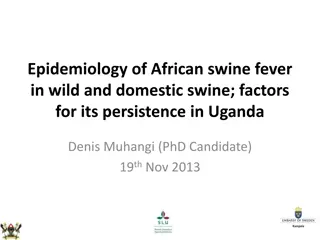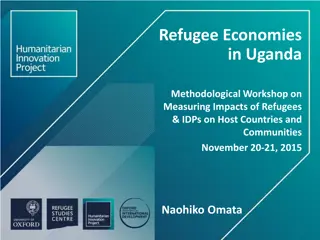Challenges and Opportunities for Women Entrepreneurs in Uganda
Women in Uganda face significant challenges due to poverty, limited access to resources, and gender disparities in the economy. Despite these obstacles, women play a crucial role in agriculture, commerce, and small businesses, contributing to the country's economy. Efforts to empower women entrepreneurs, improve access to funding, and enhance business opportunities can help alleviate poverty and drive economic growth.
Download Presentation

Please find below an Image/Link to download the presentation.
The content on the website is provided AS IS for your information and personal use only. It may not be sold, licensed, or shared on other websites without obtaining consent from the author.If you encounter any issues during the download, it is possible that the publisher has removed the file from their server.
You are allowed to download the files provided on this website for personal or commercial use, subject to the condition that they are used lawfully. All files are the property of their respective owners.
The content on the website is provided AS IS for your information and personal use only. It may not be sold, licensed, or shared on other websites without obtaining consent from the author.
E N D
Presentation Transcript
WOMENS ENTRPRENUERSHIP DEVELOPMENT LESSONS LEARNT AND EXPERIENCES FROM POLICY BY IDA KIGONYA/PWIDO MINISTRY OF GENDER, LABOUR AND SOCIAL DEVELOPMENT Thursday 15thOctober, 2015 Poortgebouw, Leiden 1
Women & Poverty Women remain the majority of people living in poverty in Uganda living on less than US$1 a day. Other vulnerable groups affected by poverty include; refugees and IDPs, female/child headed households, asset less widows, widowers, the youths, the unemployed particularly females with about 70% engaged in unpaid family work. Women s lack of access and control over the five assets/resources namely natural, human, financial, physical and social resources continues to be the major cause of poverty. Other structural factors contributing to women s poverty include; inadequate funding to programs targeting women and; most women are often limited to the lowest paying and most unstable jobs that provide the least employment related benefits. 3
Economy Uganda s economy is mainly based on subsistence agriculture which is highly vulnerable to climatic changes. Women represent 80% of the agricultural labour force, are responsible for about 80% of the food crop production and continue to contribute about 60% of the labour for cash crop production. Women are increasingly taking up commercial activities where they form 72.4 % in commerce, 63% in services, 60.5% in animal husbandry and 47.7% in manufacturing Women work longer hours (12-18hrs) a day as compared to men (8- 10hrs). 4
Women in Business in Uganda Available data indicates that one million persons were employed by the private sector in 2010/2011 compared to nearly 450 thousand in 2001. Businesses in the Trade sector continue to employ the majority where nearly 5 out of every 10 people are in the Trade sector. A majority of the employees (55%) are males. The male employees dominate in most sectors especially Business services (74%), Manufacturing (74%), Agriculture (79%). Females dominate employment in Hotels and Restaurants (70%), Education and Health (51%). 5
The Trade Sector remains the leading sector with 61% of the total businesses, followed by hotels and Restaurants with 14%. 98% of the businesses are owned by Ugandans. It is estimated that at least 43.7% of Medium and Small Enterprises (MSEs) are owned and operated by women. Medium and Small Enterprises contribute 90% of the private sector production, a source of new jobs and an income generation for the poor majority of whom are women. 29.50% of women in business in Uganda are in exports. In 2007, informal exports were 58% of formal exports. According to the National Development Plan, 40% of the private enterprises mostly at the micro enterprise informal sector are owned by women; and women form the bulk of informal traders. 6
Modernization of Agriculture Government has continued to implement gender responsive policies with a view of supporting women entrepreneurship to achieve gender equality and women empowerment. Government has prioritized funding to the Agriculture Sector mainly dominated by grass roots women focusing on moving from subsistence to commercial farming. Through the National Agricultural Advisory Services (NAADS), District Commercial Officers are assisting women in agro processing and marketing of their products. Although in some places the NAADS program was not handled properly, there are areas where it was successful and contributed to improved production in the Agriculture sector. The Uganda Food and Nutrition Policy and Strategy are in place. Food security has been emphasized and elevated as a right and priority by Govt. The Agricultural Sector funding has slightly increased because of its direct link to food security. 7
The Land Act 2004 The Land Amendment Act of 2004 includes sections that cater for the protection of the rights of women to own, use and inherit land. However, many women in Uganda still have limited access and control to land which is a key resource for agriculture production. Only 16% of women own registered land.(Ministry Records of Lands 8
SKILLS DEVELOPMENT The National Trade, Industry and Cooperative policies are meant to help women and youth to develop their trade. Vocational institutions across the country are being established to boost acquisition of skills for women and youth including female youth in the SME Sector in a bid to support lack of skills and knowledge required to manage a successful business. 9
Post Harvest Handling The Ministry of Trade, Industry and Cooperatives has embarked on the process of addressing post harvest handling an area that affects women quite a lot in terms of managing their produce. The Ministry plans to build 10 grain silos in each of the districts of Gulu, Arua, Mbale, Soroti, Mityana Hoima kyenjojo Iganga, Kabale and Bushenyi to store their produce like maize, millet before milling it for sale. Women groups are being encouraged to take advantage of the available opportunities 10
Savings and Credit Cooperative Organizations (SACCOs) The right to access credit and other financial services is being addressed by the Rural Development Strategy, particularly the Prosperity for all Program. The Program aims at improving household incomes through establishing savings and credit cooperatives at every sub county. At every sub county level, women are organized in Savings and Credit Cooperative Organizations (SACCOs) through which MSC provides them the services. Members in the circles provide guarantees for the credit instead of collateral. However, rural women are highly under served by MFIs to expand their livelihood opportunities and, MFIs regard agriculture as a high risk investment due to long gestation periods and high dependence on weather 11
Other Govt Programmes Youth Livelihood Programme implements the Youth Policy where 30% of the members in the groups are female and it covers ages 18 to 30 years. Uganda Women Program implements the Uganda Gender Policy ; this covers ages 18 to 65 years. Female youth and women entrepreneurs are encouraged to apply thru groups. Entrepreneurship 12
Export Promotion The government embarked on a deliberate strategy of Engendering the National Export Strategy. This effort is meant to ensure that: The Uganda Export Promotion Board (UEPB)carries out sensitization and affirmative support towards women entrepreneurs through business coaching, mentoring, training as well as identifying markets for their products. UEPB has a programme for Women in Cross Border Trade to provide information on the border custom services, export documentation as well as assist in filling in the documents for women entrepreneurs who cross borders to sell their merchandise. UEPB promotes women involved in coffee production to enable them reach export readiness by emphasizing value addition, packaging and branding in the coffee business. 13
Cross Border Trade Recognising the challenges faced by women in cross border trade, specifically the Non Tariff Barriers (NTBS) that hamper the business environment, the EAC Monitoring Committee on Non Tariff Barriers was formed and it is being headed by Uganda whose role among others is to sort out road barriers like road blocks, bribes paid by entrepreneurs etc. Other Cross Border Trade Associations were also formed to highlight and propose solutions to the challenges that arise as a result of the National Trade Barriers. 14
Micro finance Institutions and access to credit Realizing that commercial banking institutions require use of collateral, Government established loan schemes for women and also encouraged private sector institutions to establish micro credit schemes targeting women. Available data indicate that women dominate most of the services offered by micro-finance institutions. In a research done by Min of Finance, about 60.1 percent of the active borrowers are female and 31.9 percent are male, 56 percent of the active savers are female while 44 percent are male. Female borrowers also are dominant in all categories of economic activities. However, the average loan size is still very small for engagement in large income generating activities and saving is still limited. The average loan size is about $140 and the average saving volume is only $87. The challenge of high interest rates is an issue of concern to borrowers. 15
Micro finance Institutions and access to credit Private public partnerships are encouraged to support women entrepreneurs. For example DFCU Bank has a specific loan facility to women entrepreneurs in their diverse businesses. Other Public Private Partnership initiatives include entrepreneur skills development for women in enterprise selection, records and books of accounts, information technology; accessing financial services, marketing and business registration among others. 16
Challenges: Lack of access to markets, and even when women access markets, the payment is not equitable to the labour they put in. Limited access to women friendly financial services i.e. high interest rates, the bid for them to bring in their husbands to stand in as guarantor Limited access to markets and credit facilities Women still have barriers in using non land collateral because of the undeveloped personal and moveable property security law. Limited access to information on the EA Common Market and the opportunities available to them within this regional framework Many women in Uganda still have limited access and control to land which is a key resource for agriculture production. Only 16% of the women own registered land.(Ministry of Lands Records) Attitude of women culture of women believing that the man has to take care 17
WAY FORWARD Training of female youths in business skills with specific focus on entrepreneurial development, business planning, value addition, marketing and pricing. Capacity building for micro finance institutions on gender responsive loan management. Create awareness on economic literacy & entrepreneurship and skills development for small and medium enterprises owned by women Provision of accessible credit to women in-business who fail to access credit from other financial institutions owing to lack of collateral or high interest rates. Continuous implementation of polices aimed at poverty eradication.) Bridge the digital divide as majority of women of Uganda need training and equipment in ICT to enable them benefit from the Information age through active participation in the global village. 18
Conclusion We should continue to strive to enhance the knowledge, skills, and capacities for women to engage in production and business. In collaboration with the Private sector, Civil Society Organizations Development Partners, we can be able to mobilize the required technical and financial resources to achieve this goal. and 19
THANK YOU 20























